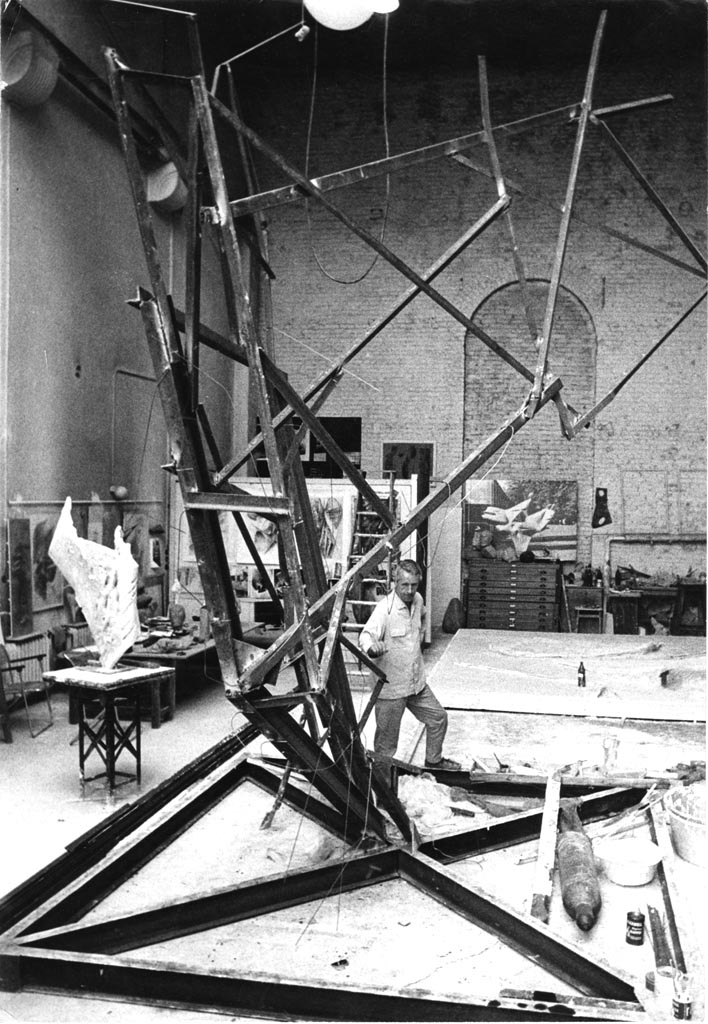
The great German sculptor, Bernhard Heiliger, in his studio at the Hochschule fuer Bildende Kunst (State Academy of Art)
Bernhard Heiliger was, at this time, the most famous sculptor in Germany. He was chosen to do the main sculpture of the Berlin Philharmonie (Philharmonic Hall).
When I met him, I was first approached by Frau Mater Heiliger because a huge book on Heiliger's sculpture was almost finished and they couldn't get decent photos of his famous Nike sculpture and two other difficult-to-photograph works. Since almost all the lucrative work or the book was already done, I wasn't flattered at being asked to rescue them for just three photographs and quoted them an enormous price that was meant to discourage the project.
Unfortunately, I was known as an artistic photographer whom many were afraid to approach for simple, lucrative jobs of no great consequence. But suddenly I received a phone call from Heiliger himself. I had a sculptors atelier in a building built in the beginning of the century by a sculptor. My downstairs neighbor, with whom I was very friendly, was the sculptor Erich Fritz Reuther, who did the mosaics for the floor of the Philharmonie entrance hall and also owned the foundry that cast all the Henry Moore sculptures at that time. Reuther was a fellow professor at Heiliger's school and Heiliger had asked Reuther about me. I did a lot of Reuther's photo work at that time and Reuther had done a bronze bust of me. Heiliger agreed to my price and pleaded with me to do the work soon, as the book was already almost finished printing.
However, sculpture photography is as difficult as photography gets. It takes enormous concentration and enormous means for lighting and setup. The sculpture had to be "seen into" so that the photo truly reflected what the sculptor meant. It was something I would only do when I was in the right mood. A very special frame of mind. Reuther understood that and left me the keys to his studio so that I just went down there and photograph when I felt like it. Heiliger told me I could come by any time and he would clear everything and provide me with helpers from his students. And that I did.
A day or so later I showed up at the Hochschule unannounced with one helper to help me get all the equipment over there. It was in the middle of one of Heiliger's classes. He immediately stopped everything, delegated his top students to help me any way I needed, and left me there to stay as long as I wanted.
The photos turned out better than even he expected and he loved the dramatic treatment of the Nike statue, which was his most famous work up till then. It is a dramatic art work and I lit it and photographed it to bring out its monumental character.
From then on, Heiliger told me to come by any time and he would clear the studio and give me something to photograph. That did not happen often, because sculpture photography takes a lot out of me. But I did also stop by a few times to photograph the master at work, and, as the photos show, he let me do whatever I wanted, while he worked on sculpture with his classes. We also often took rides around the Berlin highways in his fabulous 12 cylinder Jaguar sports car, which I loved to ride in. It was probably the most advanced car of the moment. But it was constantly in the workshop, because it needed to be regularly driven full out, full speed to stay in shape, the isolated city only allowed that when driving through the East German Autobahn, which he couldn't do often during the school year. But that was one thrilling car to ride in.
Heiliger index | Sculptors index
© 2006 Mark B. Anstendig. All rights reserved.
Gallery | People | Places | Pets | Odds and Ends | Messraster | Photos of Me | Anstendig Institute Artwork | Contact Me
Click on the Gallery to see the full list of categories